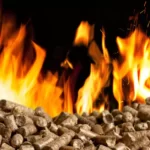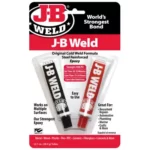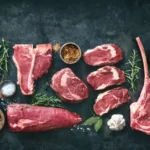The allure of smoking meat lies in the rich, smoky flavor that permeates every bite. The magic happens when heat and smoke waft through the cooking chamber of a smoker, transforming the texture and taste of the meat. Among the many elements controlling this process, the damper plays a significant role.
The position of the damper – whether open or closed – can dramatically affect the result. In essence, an open damper allows more air circulation, leading to higher heat and less smoke. Conversely, a closed damper limits air flow, generating more smoke at lower temperatures.
The damper setting, therefore, is key to achieving the perfect balance between smoke and heat. Incorrectly set dampers may result in overcooked or under-smoked meat. Hence, mastering damper use is crucial for optimum smoking results.
Understanding the Damper
Basics: What Is a Damper
In the realm of smoking meat, a damper is a device that regulates the flow of air in and out of the smoker. It’s typically a metal plate or flap located in the firebox and the chimney of a smoker.
Importance of Damper in Controlling Smoke and Heat
Control is critical when smoking meat, and the damper provides just that. By adjusting the damper, you control the quantity of oxygen that reaches the fire. More oxygen stokes the flames, raising the temperature. Less oxygen dampens the fire, lowering the heat and increasing the smoke.
Open Damper Vs Closed Damper
When it comes to smoking meat, understanding the effects of the damper’s position – open versus closed – is critical. Different damper positions produce distinct temperature and smoke levels, influencing the smoking process’s overall result.
Role of Open Damper in Smoking Meat
An open damper promotes maximum airflow into the smoker, leading to an increased oxygen supply. This, in turn, results in the following:
- Hotter Fire: With more oxygen fueling the flames, an open damper leads to a hotter fire. It’s suitable for techniques requiring high temperatures, such as grilling or searing meat.
- Faster Fuel Consumption: As the heat intensifies, the fuel, whether wood or charcoal, tends to burn quicker.
- Less Smoke: Despite the high heat, an open damper results in less smoke generation. The smoke is quickly vented out, leaving behind a subtle smoky flavor in the meat.
- Quick Cooking Time: High temperatures expedite the cooking process. However, quick cooking might not be desirable when smoking, as the goal is usually slow, gradual cooking that allows the flavors to develop.
Effects of Closed Damper on Smoking Process
Conversely, a closed or partially closed damper restricts airflow, yielding the following effects:
- Cooler Fire: Limited oxygen leads to a cooler fire, with temperatures ideal for slow cooking or smoking techniques.
- Increased Smoke: As the oxygen supply dwindles, smoke generation increases. The smoke lingers in the cooking chamber, deeply infusing the meat with smoky flavors.
- Slower Fuel Consumption: With a cooler fire, the fuel burns more slowly, prolonging the smoking process and maintaining consistent temperatures.
- Extended Cooking Time: Low and slow is the mantra for smoking, and a closed damper helps achieve this by extending the cooking time.
Impact on Meat Quality
The position of the damper not only influences the fire’s temperature and smoke levels but also impacts the meat’s quality.
Influence of Damper Position on Smoke Flavor
How smoky do you like your meat? The answer to that depends on your damper settings:
- Open Damper: With a swift smoke exit, the meat gets a mild smoky hint, perfect for those preferring a less intense smoky flavor.
- Closed Damper: If you’re after a strong smoky flavor, partially closing the damper is the way to go. The lingering smoke permeates the meat, imparting a rich, smoky taste that’s the hallmark of smoked dishes.
How Damper Setting Affects Meat’s Moisture
Besides the flavor, the damper position can also affect the moisture content of the meat:
- Open Damper: High heat can potentially dry out the meat, especially if cooked for extended periods. Thus, it’s crucial to monitor the cooking process closely and make necessary adjustments to avoid dry, tough meat.
- Closed Damper: Lower temperatures help to retain the meat’s natural juices, yielding tender, moist results. However, ensure the temperature doesn’t drop too low, as this could result in undercooked meat.
Best Practices for Damper Use in Meat Smoking
Using a damper effectively can be the difference between perfectly smoked meat and a smoking disaster. Here are some best practices:
Initial Positioning of the Damper
At the start, it’s advisable to have the damper fully open. This allows the fire to catch quickly and establish a stable temperature. Once that’s achieved, you can adjust the damper according to your needs.
Adjusting Damper According to Smoke and Heat
To maintain the desired temperature and smoke levels, monitor the smoking process closely:
- If the temperature rises too high, partially close the damper to reduce airflow and lower the heat.
- If more heat is needed or the smoke is too heavy, open the damper a bit more to increase airflow and raise the temperature.
Factors Influencing Damper Adjustment
When deciding on the best damper position, consider the following factors:
- Type of Smoker: Different smokers may require varying damper settings for optimum results.
- Fuel Used: The kind of fuel, such as charcoal or wood, can influence how quickly it burns and how much smoke it produces.
- Meat Type: Different meats might require specific temperatures and smoke levels for ideal outcomes.
- Weather Conditions: Cold or windy weather can affect the smoker’s internal temperature, necessitating adjustments to the damper position.
Common Mistakes to Avoid
Incorrect Damper Settings and Their Consequences
Too much heat or smoke can ruin the flavor and texture of the meat. Avoid keeping the damper fully open or closed for the entire cooking process.
Tips for Damper Management
Be patient and avoid making abrupt changes to the damper position. Small, incremental adjustments are often sufficient to maintain the desired temperature and smoke level.
Safety Measures
Dangers of Fully Closed Damper
A fully closed damper can cause carbon monoxide buildup, which is hazardous. Always ensure some degree of ventilation.
Ensuring Proper Ventilation
Ensure that your smoker is well ventilated throughout the cooking process. A good practice is to keep the exhaust damper open to a degree at all times.
Frequently Asked Questions
How Often Should I Adjust the Damper?
It depends on various factors, including the type of meat, the smoker, and the outside temperature. Monitor the smoking process closely and adjust the damper as needed.
Can I Smoke Meat with the Damper Fully Open?
While it’s possible, a fully open damper burns fuel faster and generates less smoke. For most smoking needs, a partially open damper is recommended.
Does the Damper Position Affect Different Meats Differently?
Yes, the damper position does impact different types of meat differently. More delicate meats, such as fish, might require a lower temperature and more smoke, thus a more closed damper.
Conclusion
In the art of smoking meat, understanding the role and operation of the damper is critical. The damper’s ability to regulate smoke and heat within the smoker directly affects the meat’s flavor and texture.
Proper use of the damper helps achieve the right balance between heat and smoke. From subtle smoky undertones to rich, robust flavors, damper settings can shape the final result significantly.
Mastering damper control can elevate your meat smoking experience. It allows for experimentation, adaptation, and ultimately, the creation of perfectly smoked meats that satisfy the palate and the soul. After all, the joy of smoking meat lies not only in the end product but also in the process.







